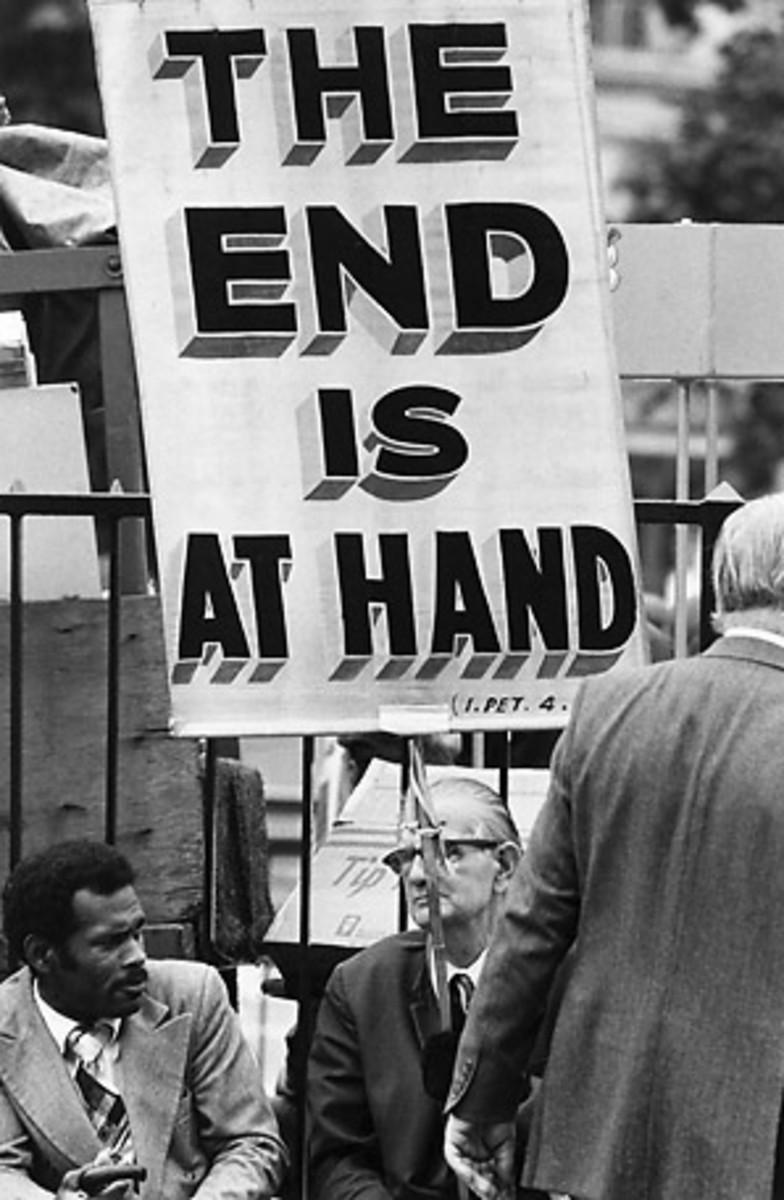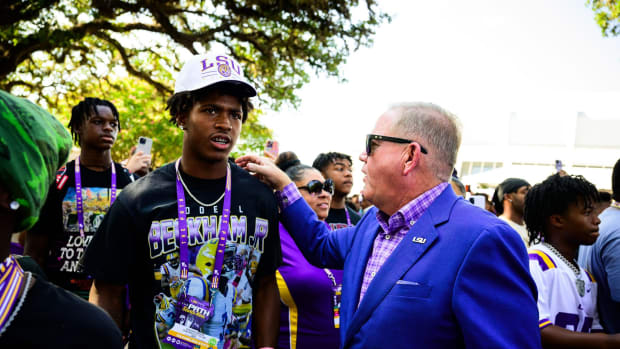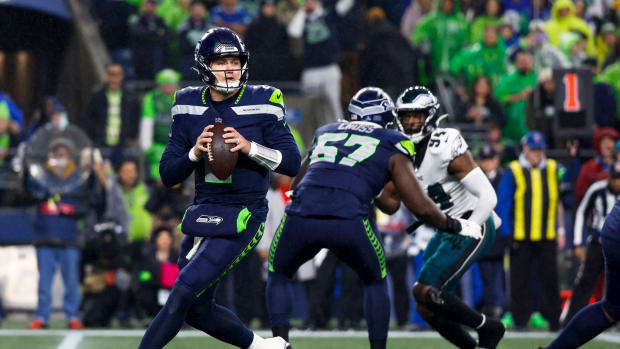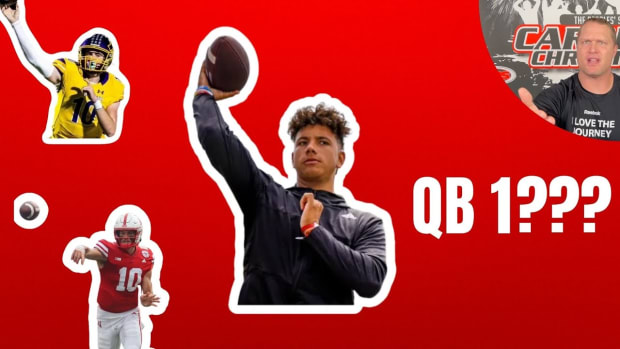The college football apocalypse is nigh! Or is it?
Since the most cracked pots among us believe the world will end sometime on Dec. 21, let's take a moment to examine a conclusion of an era that seems far more likely: the end of college football as we know it. Forces have aligned that seem to portend doom. Let us count the ways...
? On the topic of the danger of football, the following passage appeared in TheNew York Times: "Public sentiment is yearly growing stronger against the brutality of the game, he declared, and the death of a man in order to win a game will result sooner or later in universal condemnation of it as part of college athletics."
? On realignment, the head of the American Football Coaches Association said this: "It's like we had this herd of cattle going toward the?cliff. We tried to head them off, but none of us were able to do it."
? On the sudden departure of schools to another conference, a university chancellor said this: "I want to emphasize that this is not a normal case of member withdrawal from an athletic conference. This is a case that involves broken commitments, secret dealings, breaches of fiduciary responsibility, the misappropriations of conference opportunities and predatory attempts to eliminate competition."
? On television's outsize influence in college football, the NCAA president said this: "A small number of television networks now can manipulate the college football market the way they wish."
? On NCAA rule violators, the NCAA president said this: "[It] hasn't cleaned up the so-called 'pig-sty.' But we are working and as we go along we will have less violations. It will take years to completely clean house."
? On the same topic, the head of the NCAA also said this: "We're not keeping up with the chase. I've talked with our representatives and people I respect and the problem is much worse than I thought."
? On the class struggle between the haves and have-nots affecting the product on the field, a major football coach said this: "I think the whole thing was brought about by pressure from the small colleges."
? Meanwhile, that class struggle produced this exclamation from the NCAA president: "The future of the NCAA is at stake. If we don't start doing something, we're not going to have an NCAA farther down the road."
Sounds positively awful, doesn't it?
Something probably seems a little off about all these statements, though. Sure, NCAA president Mark Emmert loves microphones, but -- when read aloud -- not all those quotes sound as if they came from his mouth.
That's because none of them did. None of the above passages appeared in print in 2012. The most recent is nine years old. The least recent is 107 years old. People have been hyperventilating for more than a century over essentially the same issues. Every decade, new voices predict one or more of those issues will bring about the end of college athletics, yet the games go on and the enterprise grows bigger every year.
Photos: SI's Signs Of The Apocalypse
The New York Times has published quite a few stories recently about the long-term dangers of the brutality of football, but the story excerpted above was published in 1905 after President Teddy Roosevelt met with the most powerful people in college football and demanded changes to the game to make it safer. This prompted a package of rules changes that would render the game unrecognizable within a few short years. One of the most radical changes was the legalization of the forward pass. So when you laugh at people who suggest that kickoffs should be banned to improve safety, remember that people once laughed at the notion of a legal forward pass.
That quote about realignment from the executive director of the AFCA came from 1994, when former Baylor coach Grant Teaff -- who still runs the AFCA -- lamented the demise of the Southwest Conference to the Houston Chronicle. The other quote about realignment came from Pittsburgh chancellor Mark Nordenberg in 2003 when the remaining members of the Big East sued Miami and Boston College after those schools announced their intention to leave for the ACC. Eight years later, Nordenberg would plunge a knife into the Big East himself when he led the Panthers to the ACC. Conference memberships have always been relatively fluid. They always will be.
While it is completely true that a small number of television networks do essentially control major college sports now, NCAA president John Toner gave the above quote to The New York Times in 1984 after the U.S. Supreme Court ruled in favor of the universities of Georgia and Oklahoma in their lawsuit against the NCAA's control of college football television rights. Guess what else happened because of that ruling? Fans of South Carolina, Arizona State, Iowa and dozens of other schools that rarely played on television under the old system can now watch every single game their teams play.
The NCAA president charged with cleaning the pigsty was Karl Leib. He spoke those words to a United Press International reporter in 1949. He was discussing the Sanity Code, which was the NCAA's first attempt to enforce its rules nationwide. And what was the grave offense the NCAA wished to curb? Scofflaw schools were paying room and board for athletes. So when Emmert or some other guardian of the status quo swears that college athletes will never get paid beyond a scholarship, remember that fewer than 70 years ago, most high-ranking officials in college sports swore that schools would never be allowed to give room and board and that less than 100 years ago, the leaders of college sports swore they would never allow athletic scholarships at all. The other quote about rule-breaking came from NCAA executive director Walter Byers to UPI in 1984. At the time, the SWC schools worked much harder on out-cheating one another than they did at keeping the league together. Until the NCAA adopts my rulebook, schools will continue to cheat. They'll probably keep cheating even with those lax rules, but it's harder to cheat when very little is illegal.
Meanwhile, the class struggle that threatens to rip apart the top division in college sports is nothing new. The first quote on the topic came from Ohio State coach Woody Hayes to a UPI reporter in 1953 after schools voted to ban the platoon system and force a return to ironman football because schools at the bottom of the food chain couldn't afford to carry enough players on their rosters to field separate offenses and defenses. The second statement came from NCAA president J. Neils Thompson to UPI in January 1977 as the most powerful football schools threatened to break away and form their own association. Before the NCAA could rupture, the schools in the uppermost division agreed to split into two subdivisions: I-A and I-AA.
Almost every issue faced by major college football today is essentially a reheated version of an issue faced 10, 20, 50 or 100 years ago. Every time, the game and the people who run it have adapted. Those who romanticize the way things used to be cheerfully ignore the fact that college football has been in flux for as long as it has existed.
College football isn't doomed. There will always be another conference hopper or scandal or court case that threatens to tear asunder the union of universities and the teams that carry their banners. But the games will go on. They always do.






